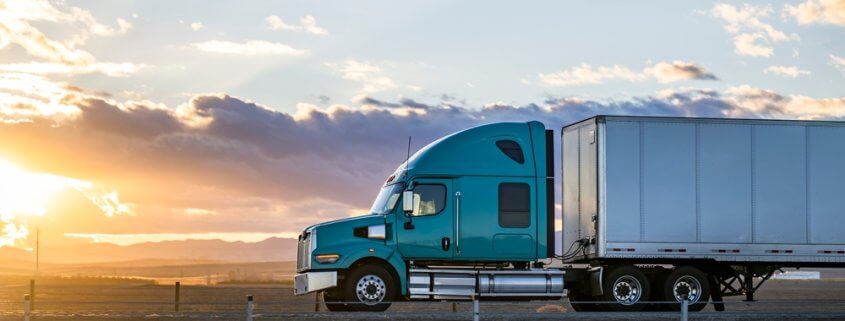Leasing-On vs. Operating Under Your Own Authority as an Owner-Operator
Last Updated April 29, 2024
Entering the trucking industry as an owner-operator comes with one consequential decision in particular: whether to lease-on with a motor carrier or operate under your own authority.
This choice defines not just the legal and operational framework of your business – but its potential for growth, independence, and profitability. Understanding the differences, responsibilities, benefits, and challenges means you’re making an informed and intelligent decision that fits your situation the best.
Here, we outline the difference between owner-operators who lease-on vs. operate under their own authority, helping both newcomers to the trucking world and seasoned truck drivers with insights to make the best decision.
What Is an Owner-Operator?
An owner-operator in the trucking industry is an individual who owns and operates their own trucking business. They are essentially self-employed, owning their vehicle(s) and managing their operations. The role requires balancing the responsibilities of driving and business management.
Owner-operators can either operate under their own authority – meaning they have their own trucking authority granted by the government – or they can lease-on to a motor carrier and work under another company’s authority.
Owner-operators are responsible for various aspects of their business, including maintaining their truck, managing finances, and securing loads. This independence allows for greater control over their routes, schedules, and business decisions. However, this also means taking on the risks and challenges that come with running a small business.
What Is Trucking Authority?
Trucking authority, often referred to as motor carrier authority, is the official permission granted by regulatory bodies – such as the Federal Motor Carrier Safety Administration (FMCSA) in the United States – for individuals or companies to operate as a motor carrier. This authority signifies compliance with all the necessary legal, safety, and insurance requirements to conduct trucking operations.
There are different types of trucking authority. Each caters to specific operational scopes, such as hauling household goods for moving purposes or hauling specific types of cargo. Obtaining your own trucking authority involves a thorough process, including applying for a USDOT number, meeting insurance requirements, and passing safety audits.
But having your own authority as an owner-operator means a higher degree of operational independence vs. being a standard company driver. It allows truckers to choose their loads, routes, and schedules – and to negotiate directly with clients. However, it also comes with increased responsibilities like full compliance with regulatory requirements, managing all aspects of the business, and bearing all operational costs.
Leasing-On to a Motor Carrier vs. Operating Under Your Own Authority
Leasing onto a motor carrier means an owner-operator is operating their truck under another company’s trucking authority. Meanwhile, becoming an owner-operator with your own authority means you have secured trucking authority and are fully independent.
Owner-Operators Who Lease-On
When an owner-operator leases-on to a motor carrier, they essentially become part of another company’s operation – but with a bit of independence. This is how it works in practice.
Responsibilities When Leasing-On
Leasing-on to a motor carrier means certain responsibilities for the owner-operator. They must maintain their own vehicle, ensuring it is in good condition and meets all safety standards.
Additionally, while they operate their own truck, they are required to comply with the carrier’s policies and operational procedures. This includes adhering to the carrier’s safety standards and schedule requirements.
Financially, the owner-operator is responsible for their own expenses such as fuel and maintenance costs. They also need to pay a portion of their earnings to the motor carrier as part of the leasing agreement.
Benefits of Leasing-On
The benefits of leasing-on to a motor carrier are significant. First, the carrier provides administrative support, handling tasks like securing freight, managing logistics, and handling compliance issues. This reduces the administrative burden on the owner-operator, allowing them to focus more on driving and less on paperwork.
Another major advantage is the steady workflow. Motor carriers often have established networks and client bases – providing a more consistent and reliable flow of work. Leasing-on typically involves lower upfront costs compared to operating under one’s own authority. The motor carrier absorbs many of the operational expenses and overheads.
Challenges of Leasing-On
But leasing-on to a motor carrier is not without its challenges. The most significant one is the reduced level of independence. Owner-operators have limited freedom in choosing their loads and routes because those decisions are primarily made by the motor carrier.
Financially, they must share a portion of their revenue with the carrier. Moreover, the owner-operator’s business is somewhat tied to the carrier’s reputation and business practices. That means any negative aspects of the carrier could indirectly affect their own business.
Owner-Operators Who Operate Under Their Own Authority
Choosing to operate under your own authority is a step toward complete business autonomy. This path, while offering greater freedom and potential for higher earnings, requires a comprehensive approach to business management.
Responsibilities When Operating Under Your Own Authority
The owner-operator is entirely in charge of their business, which includes not just driving the truck but handling all admin work. They secure their own loads, manage logistics, and ensure compliance with transportation and safety regulations.
They are responsible for their truck’s maintenance and repairs, insurance, and managing all business-related finances. It provides greater control but demands a more comprehensive approach to business management.
Benefits of Operating Under Your Own Authority
The main benefit of operating under one’s own authority is complete independence. Owner-operators have the freedom to choose their loads, negotiate rates, and plan their routes and schedules. This autonomy means greater flexibility in balancing work and personal life.
Plus, it commonly leads to higher earnings. All revenue generated from the hauls goes directly to the owner-operator without the need to share profits with a motor carrier.
Challenges of Operating Under Your Own Authority
Of course, operating under one’s own authority comes with significant challenges. The owner-operator is solely responsible for finding and securing loads, which can be time-consuming and require a good understanding of the market. They also face the full burden of compliance with regulatory requirements, which can vary by region.
Financially, the initial setup and ongoing operational costs can be substantial – including insurance, maintenance, and fuel costs. It also requires managing business aspects such as bookkeeping, client relations, and marketing.
How to Get Your Own Trucking Authority
The process for getting your own trucking authority is similar to acquiring any other qualifications. We’ve outlined the holistic process here, and the basic steps are the following:
- Register Your Trucking Business
- Get Your USDOT Number
- Apply for Your MC Number
- Complete the BOC-3 Form
- Obtain Insurance
- Pay Your HVUT
- Register and Agree to the IRP
- Get an IFTA Account
- Get a UCR Permit
- Pass a Drug and Alcohol Test
- Comply with Federal Regulations
Whether you’re new to the trucking business or want to move toward the greater autonomy that own authority provides, understanding the responsibilities, benefits, and challenges of leasing-on vs. own authority is important for making an informed decision. If you know that operating under your own authority is your goal, then you’re ready to start the process of registering your trucking business and enjoying your newfound freedom.
Lease-On vs. Own Authority FAQs
Below are some common questions related to owner-operators who lease-on vs. operate under their own authority.
How can I become an owner-operator?
To become an owner-operator, you need to first gain experience in the trucking industry, typically as a company driver. Once you understand the basics, the next step is to acquire a truck, which can be done through purchase or lease. After securing a truck, you can decide whether to lease-on to a motor carrier or obtain your own authority, each path having its own set of requirements and challenges.
Can I start a trucking business with just one truck?
Yes, you can start a trucking business with one truck, and it’s quite common. While starting small limits the number of loads you can transport at one time, it also allows you to manage your business more closely and grow steadily.
Yes, an owner-operator can operate without having their own trucking authority by leasing-on to a motor carrier. In this arrangement, the owner-operator drives their own truck but operates under the motor carrier’s authority and follows their guidelines and policies.
Getting loads with your own authority requires networking, building relationships with shippers, and often using load boards. Owner-operators with their own authority have the freedom to choose their loads but also bear the responsibility of finding and securing these loads themselves.
Letting someone run under your authority means you allow another truck driver or owner-operator to operate using your trucking authority. This arrangement requires a formal agreement. You must also ensure that the driver meets all the necessary insurance and regulatory requirements. It can expand your business operations but also add a level of responsibility in terms of management and compliance.
Michael McCareins is the Content Marketing Associate at altLINE, where he is dedicated to creating and managing optimal content for readers. Following a brief career in media relations, Michael has discovered a passion for content marketing through developing unique, informative content to help audiences better understand ideas and topics such as invoice factoring and A/R financing.




